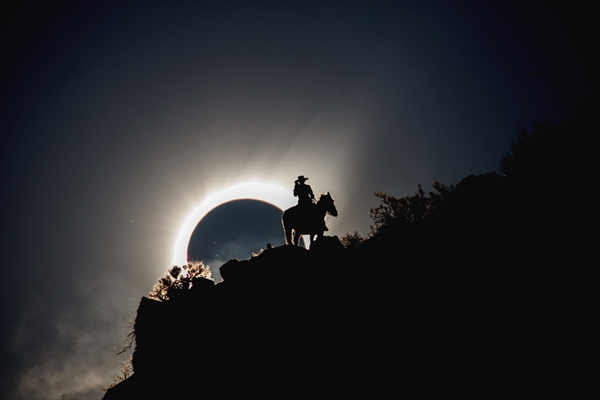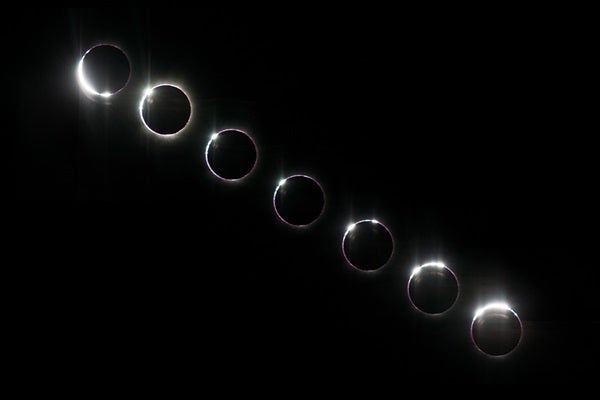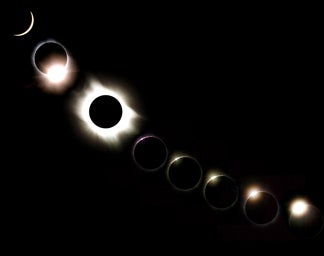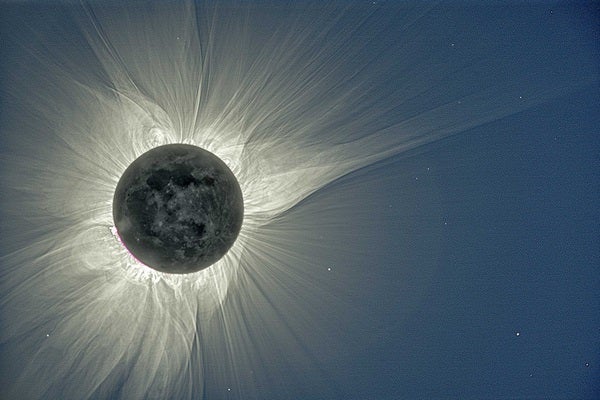On August 21, 2017, millions who live in or traveled to the United States witnessed a spectacular event — the first total solar eclipse in the continental U.S. in 38 years. The narrow path of totality on American soil started in Oregon and ended in South Carolina, captivating all of those fortunate enough to witness it. But after the excitement of the Great American Eclipse died down, every viewer was left with just one question: “When is the next one?”
The answer, happily, is April 8, 2024. That’s when the next total solar eclipse will cross the United States. And although six years and seven months (plus 19 days) sounds like a long time since August 21, 2017, it’s much shorter than the average time between two eclipses appearing at a given location on Earth (330 years in the Northern Hemisphere and 550 years south of the equator).
The length of totality varies from one total solar eclipse to the next. That’s due to the fact that Earth is not always at the same distance from the Sun, and the Moon is not always the same distance from Earth. The Earth-Sun distance varies by 3 percent and the Moon-Earth distance by as much as 12 percent. The result is that maximum duration of totality for any eclipse between 2000 B.C. and A.D. 3000 is 7 minutes 29 seconds. (However, that extra-long eclipse doesn’t occur until July 16, 2186, so don’t get too excited for it.)
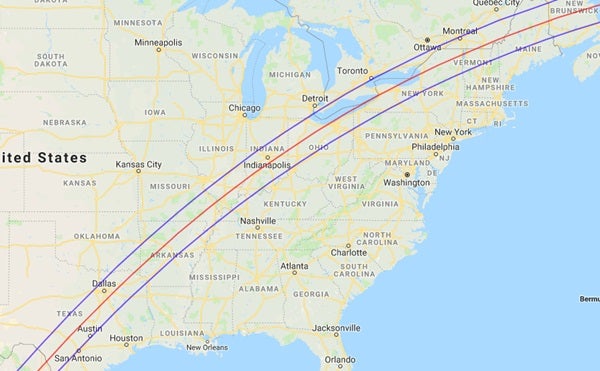
While the maximum length of totality during the April 8, 2024, eclipse won’t be that long, it’s still a worthy chunk of time: 4 minutes, 28 seconds. And as with the Great American Eclipse in 2017, everyone in the contiguous U.S. will at least be treated to a partial eclipse. In fact, as long as you have clear skies on eclipse day, the Moon will cover no less than 16.15 percent of the Sun’s brilliant surface — and that minimum coverage comes at Tatoosh Island, a tiny speck of land west of Neah Bay, Washington. But keep in mind, although our satellite covering any part of the Sun’s disk sounds cool, you’ll want to set your sights higher.
Likening a partial eclipse to a total eclipse is like comparing almost dying to dying. If you are outside during a solar eclipse with 16 percent coverage, you won’t even notice the Sun getting darker. And it doesn’t matter whether the partial eclipse above your location is 16, 56, or 96 percent; only totality reveals the true celestial spectacles: two diamond rings, the Sun’s glorious corona, 360° of sunset, and stars revealing themselves in the daytime.
To see any of this, you must be in the path of totality. That said, your next goal is to be as close to the center line as possible. The fact that the Moon’s shadow is round means that the longest eclipse occurs at its center line, because that’s where you’ll experience the lunar shadow’s full width.
The big day: April 8, 2024
The Moon’s shadow first touches Earth just north of Penrhyn Island, one of the Cook Islands in the South Pacific. That location will experience a 98-percent partial eclipse. Seventy-three minutes later, totality first strikes land at Socorro Island, a possession of Mexico. If you choose that location to view the eclipse, be sure to position yourself at the island’s far southeastern tip — you’ll enjoy an extra 34 seconds of totality there. (The span is 3 minutes 36 seconds.)
The shadow’s path covers a few more tiny islands before it encounters North America just southeast of Mazatlán, Mexico. Viewers at that location will enjoy an impressive 4 minutes 27 seconds of totality. And if you wish to stay in Mazatlán itself, you’ll lose only 10 seconds off that span.
The greatest duration of totality — 4 minutes 28.1 seconds — occurs when the shadow reaches San Martín, north of Torreón and roughly half the distance from the coast to the Mexican border with Texas. Fortunately, the duration of totality along the center line is never more than 1 second less than this maximum during the shadow’s more than 550-mile (885 kilometers) voyage through Mexico.
The eclipse crosses the border
Totality first reaches the United States when the Moon’s shadow crosses the Rio Grande River at the wonderfully named Radar Base, Texas, which lies in Maverick County. There, totality lasts 4 minutes 27 seconds. As the eclipse progresses through the Lone Star State, a huge number of people won’t have to travel anywhere to see it. That said, venturing just a few miles to the center line can increase their duration of totality.
San Antonio, Austin, Waco, Dallas, and Fort Worth all lie under the shadow, although none is on the center line. Still, that’s more than 11 million people who can experience the eclipse with little to no effort. And we’re not even out of Texas yet.
The center line then passes through Oklahoma, Arkansas, Missouri, Illinois, Indiana, Ohio, New York, Vermont, and Maine. Those wishing to observe the eclipse from the same location the center line crossed during the August 21, 2017, eclipse should head to a location near Makanda, Illinois, which lies just south of Carbondale. A word of warning, if I may: The weather in Illinois in April — and I’m specifically talking about cloud cover here — is a far cry from what it is in August. Your chances of actually seeing the 2024 eclipse increase dramatically as you move toward the southwest. Not to mention that you’ll pick up an extra 15 seconds of totality from center-line locations near San Antonio.
Other major cities in the 2024 eclipse path include Little Rock, Arkansas; Indianapolis, Indiana; Dayton and Cleveland, Ohio (with northwestern parts of Cincinnati and Columbus under the shadow); Buffalo, Rochester, and Syracuse, New York; and about half of Montréal, Québec, Canada.
A long wait after 2024
For those wanting to view another total solar eclipse in the contiguous United States after the 2024 event, it’ll be a 20-year wait until August 23, 2044, for the next one. Plus, that eclipse is visible only in north-eastern Montana and a tiny segment of North Dakota. Its greatest duration of totality, 2 minutes 4 seconds, happens over Canada’s Northwest Territories.
At the intersection of the center line of the 2044 eclipse and the United States-Canada border, totality is 20 seconds shorter: 1 minute 44 seconds. The small towns near that point, namely Hogeland and Turner, Montana, experience totalities only a few tenths of a second less than that. And the Montana cities of Chinook, Zurich, Harlem, Dodson, and Malta lose only another second.
After 2044, three more total solar eclipses track through the contiguous United States in the 21st century. So, if 2044’s eclipse disappoints you, you’ll be thrilled to know that another happens less than one year later. The event on August 12, 2045, is a truly spectacular cross-country eclipse — with totalities lasting 4 minutes 23 seconds on the Northern California coast to an amazing maximum of 6 minutes 6 seconds at Port St. Lucie, Florida.
Next, the center line of the total solar eclipse on March 30, 2052, lands only on Florida and Georgia, but totality in that small path will only last between 3 minutes 30 seconds in Savannah, Georgia, and 3 minutes 44 seconds near Laguna Beach, Florida. The final total solar eclipse whose path intersects the contiguous United States in the 21st century occurs May 11, 2078. Like the eclipse in 2052, this one also tracks through the southeastern United States. Totality will last 5 minutes 17 seconds in Nags Head, North Carolina.
For those of you who stood beneath the Moon’s shadow in 2017, no convincing will be necessary to get you to seek out darkness in 2024. If you can catch it, an eclipse is a sight you’ll never rate as anything other than awesome. Just be sure to check the weather first!

